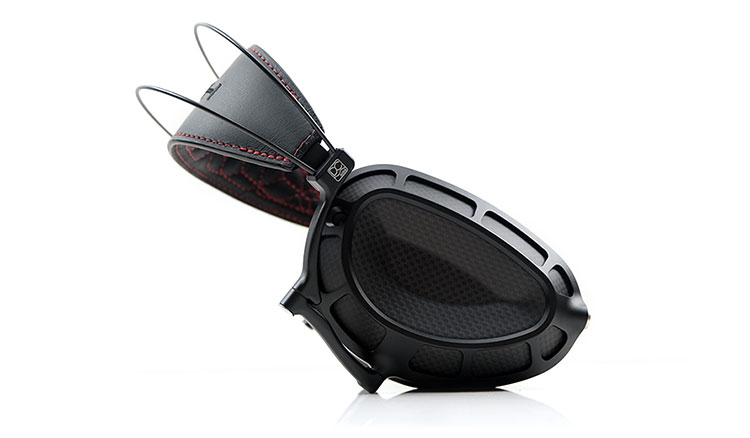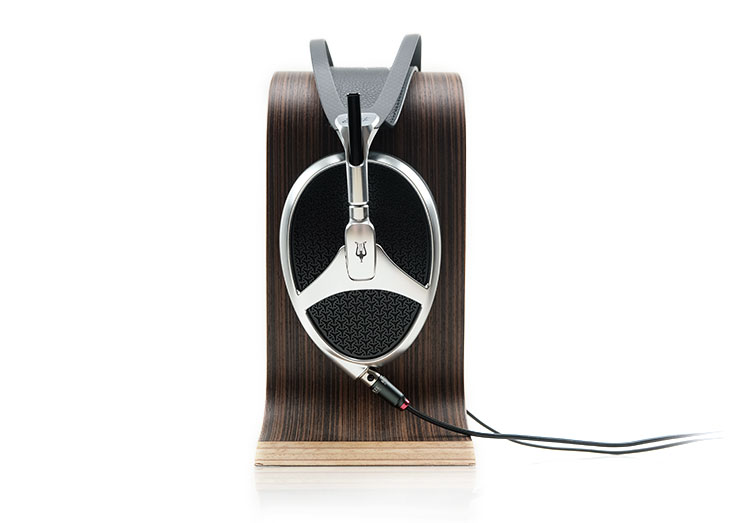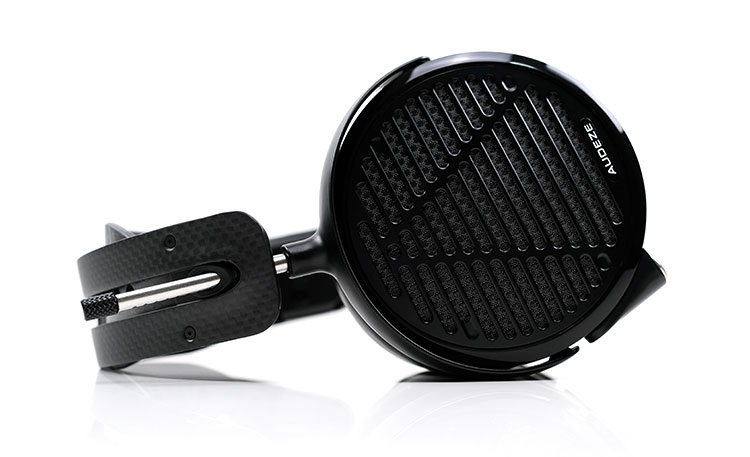Select Comparisons
All comparisons were done using a Holo Audio Spring 2 DAC combined with the Feliks Audio Envy and the Cayin HA-300MK2 amplifiers.
Dan Clark Audio Stealth
The Stealth was launched around a year ago and was our Top Gear award-winning closed-back headphones for 2021. You can read our full review here in more detail.
$3999.99
Technical
The closed-back sibling uses the same 4th gen 76mm V-Planer driver as well as the subset AMTS technology or Acoustical Metamaterial Tuning System to give it its full name.
We have gone into considerable detail already on the differences between these two headphones but to summarize the key difference here is both the tuning tweaks DCA has done with the EXPANSE driver and the specific filtering and waveguide terminations inside their respective AMTS ‘wedges’.
Neither are the same and as Dan has mentioned, they are not interchangeable meaning the closed-back Stealth AMTS configuration will not work in the open-back EXPANSE and vice versa.
Aside from that the ratings on paper will more or less match at 23Ω nominal impedance and 86-87 dB/mW so both will need a quality amplifier with a healthy mix of voltage and current headroom to get the best out of either headphone.
Using a Feliks Audio Envy balanced output on the high impedance setting I found the Stealth just to run maybe 1-2dB easier than the EXPANSE though the closed-back effect can deliver a bit of placebo.
Design
The most immediate design differences between these two headphones are the cup aesthetics. The generative cup grill finishing for the EXPANSE is more eye-catching and complex looking compared to the more muted but equally finely shaped closed-back cup of the Stealth.
Aside from the change in sticking color from red to blue and a switch from the Stealth logo to EXPANSE on the top of the USA vat-dyed leather strap, these two have a very similar mix of materials and construction.
That means the same lightweight nickel titanium for the headband, protein leather, and vegan suede mix for the pads, and an anodized aluminum cup frame.
Both articulate in the same manner with matching low-profile carry cases and both carry the same VIVO stock cable including matching termination options. Sadly, the EXPANSE doesn’t come with that nice Stealth leather display case.
One final mention on isolation. The Stealth does isolate a little bit better but the EXPANSE is not wide-open and does carry a small degree of welcome isolation without actually sounding like a closed-back.
Otherwise, given their matching weight, pressure distribution, and ovoid design, both headphones are equally incredibly comfortable on the head.
Performance
Quite apart from the obvious soundstage differences going from closed to open, the tuning between these two has some divergences also with the EXPANSE bringing the bass energy and the Stealth a bit more upper-mids sparkle.
The EXPANSE staging is immediately noticeable by how easily spatial notes dissipate and fade into airy nothingness.
Whereas the Stealth, as open as it is for a closed back, just comes off a little more intimate with notes hitting a nuanced or very soft ‘brick wall’ and not fading in quite the same manner as the EXPANSE.
Some of that smoother dissipation is also tonally related. The EXPANSE sounds liquid-toned with stronger even-harmonics through the mids and highs compared to the cooler and feistier Stealth presentation.
Though both have good head gain around 1-3k, the Stealth sounds a shade brighter in comparison through the mids though still fairly natural to my ear. There is a bit more excess 6-10k treble energy in the Stealth compared to the EXPANSE which I think colors the upper mids with a bit more contrast.
The EXPANSE comparative warmth also comes from picking up a lot more 100-400Hz energy on the lows into the lower mids.
I think both extend quite well below 100Hz, perhaps more noticeable on the Stealth because it has less of a punch through the mid-bass whereas the EXPANSE delivers a lot more punch with a stronger elevation post-100Hz.
As a result, the extension on both is the same but the EXPANSE sounds more energetic and denser through the mid-to-upper-bass and helps to fill out instrumental notes a lot more while providing a more noticeable fundamental.
Meze Audio Elite
The Meze Audio Elite was launched last year and is the company’s current flagship headphone with a price point virtually the same as the EXPANSE. You can read our in-depth review in more detail here.
$4000
Technical
Both companies have proprietary planar driver technology; Meze is partnering with Rinaro for their Isodynamic Hybrid Array and DCA using their 4th gen 76mm V-planar driver technology.
The approach to fine-tuning and creating the desired sound signature for these drivers is also quite different. For the Elite, (and the Empyrean), Meze/Rinaro focused on the voice coil and trace pattern shaping itself combined with the magnet array creating a continuous trace but with two unique shapes.
At the top, is a curved line switchback trace that focuses on the low-end delivery (bass), and the circular pattern at the bottom, is designed to focus on the mids and highs.
The bottom circular pattern delivers shorter soundwaves that tend to diffuse quicker if delivered over a wider area so it is positioned directly over the ear canal to maximize the mid-high frequency delivery and its imaging.
The EXPANSE’s main emphasis is AMTS for waveguide manipulation and diffusion control as well as the programmable Helmholtz or quarter-wave resonator to control those high-frequency standing waves and resonance.
On paper, the Elite is rated at 32Ω and 101dB SPL compared to the EXPANSE at 23Ω nominal and a much lower 87-88dB SPL. As has always been the case with Meze versus DCA headphones, you need a lot more power to drive the EXPANSE compared to the Elite.
Design
The aesthetics here are very different. The Elite is the bigger form factor with a more striking curvature and a brighter silver finish. The EXPANSE is, well, stealthier with that unique articulating foldable design.
It is also more mecha in its looks and aggressive in a way with that unique generational design grill as opposed to the exotic quasi-Persian styling of the Elite equivalent.
I think Meze and DCA are possibly the two best companies in terms of creating very comfortable and easy-to-wear headphones.
Both the EXPANSE and the Elite have some seriously good pressure balance with perhaps an edge to the Elite for overall comfort levels but I think that is primarily due to the looser clamp and wider headband whereas the EXPANSE sits tighter to your head creating a steadier fit in the process.
The ovoid-shaped earpads on both headphones have good sizing with the Elite the slightly bigger of the two. Neither will touch your ears but the stronger clamping on the EXPANSE will bring its pads a bit tighter on your head.
Cables differ a bit also with the mini-XLR system of the Elite and a stock nylon-jacketed OFC cable that is a bit stiff and just ok in terms of performance. I prefer Meze’s superior Furukawa PCUHD copper balanced cable for the Elite in the same fashion as I think the heavier VIVO cable outperforms the previous DUMMER version.
Performance
Which way you go with these two will depend on what you prefer, tonal forgiveness or technical insight. On a technical level, the EXPANSE does resolve a bit better, especially through the highs which deliver more headroom and nuanced resolution in those subtle spatial notes.
And yet, the Elite tuning is incredibly easy to like and of the two it is the more forgiving also, both of low levels of power or tonally challenging sources. It has a richer timbre, a more liquid midrange tone, and fuller-sounding instruments and vocals.
The EXPANSE tonal coloration is a bit more neutral, with less mid-to-upper bass bloom and a stronger treble tuning. Combined with a superior staging stretch and enhanced space, you can dig in between and behind those lead vocals and hear a lot more of what is happening on the stage with the EXPANSE.
When A/B’ing the same track between the two you can’t help but hear a busier more complex and holographic recording. It’s a more challenging listen but in a good way because the imaging teases a lot more of the track’s unique acoustical arrangement and uneven true-to-live character in instrumental texture for live recordings.
The Elite simplifies the same audio track in a way by dialing back on the treble energy and giving the audio a more rounded less complex arrangement combined with a stronger euphonic and slightly darker presentation.
It is less challenging in its delivery so you end up enjoying the Elite’s smooth blended sound but perhaps at the cost of not hearing every single piece of detail the track has to offer.
Audeze LCD-5
The LCD-5 is part of Audeze’s flagship series though most would say it’s the top dog from their separate LCD lineup which now forms part of their new origin series. You can read our full review of the LCD-5 here.
$4500
Technical
Like the EXPANSE, the open-back LCD-5 represents an almost entirely new approach to Audeze’s previous work on headphone planar driver design. It uses a slightly larger driver size at 90mm compared to 76mm inside the EXPANSE but smaller than their legacy 106mm LCD driver they worked with in one shape or another for years.
The LCD-5 driver has still been implemented with Audeze’s current Fazor waveguide, a nano-scale diaphragm thickness, as well as 14 Neodymium N50 magnets in a single-sided Fluxor magnet array.
The EXPANSE also makes hay on its driver diagram thickness being the thinnest yet manufactured by DCA as well as tensioned in such a way as to improve distortion control. DCA’s TrueFlow is probably closest to the FAZOR system in terms of intent, i.e., control or reduce diffraction around the magnets
The LCD-5’s improved trace pattern, (Nano-scale Parallel Uniforce), also means it is much easier to drive compared to the EXPANSE’s V-planer driver at 14Ω and 100dB SPL compared to 23Ω and 87-88dB SPL.
I still think a quality amp will make the LCD-5 sound ideal though but in terms of getting dynamic and loud, it is far less demanding compared to the EXPANSE.
Design
Aesthetically both are beautiful creations with the LCD-5 having more of a classic round cup design and the EXPANSE that teardrop shape. In a way, each plays true to the house design language of each company with the EXPANSE born out of the AEON visual and the LCD-5 true to the LCD aura.
The difference really in the evolution is just better and lighter materials such as carbon fiber, more inventive construction techniques such as the folding articulation of the EXPANSE, and simply modernizing the headphones to keep everything looking fresh and interesting.
The LCD-5 weighs almost the same as the EXPANSE and has a design language that is almost as attractive to me. However, it is simply not as comfortable to wear as the DCA design and there are a few reasons for that.
The first is the pressure distribution. The LCD-5 clamps a lot harder and makes it more restrictive for longer listening sessions. The second is the contact surface area of the newly designed pads being too narrow and creating a sharper sensation on the head when combined with the forceful clamp.
The EXPANSE has none of that with ovoid cups and a wide pad surface contact area as well as a softer clamp with excellent pressure distribution.
One peripheral note is the carry case. Audeze’s weather-sealed cases are fantastic though much bulkier. The tiny carry case of the EXPANSE hammers home just how compact this flagship can get but not entirely sure how well it seals against the elements.
Performance
The most immediate difference is the bass response. The EXPANSE has a stronger punch and a deeper sub-bass presence generating more depth and power behind its instrumental fundamental.
The LCD-5 bass is flatter, but perhaps a shade more articulate. As a result, it is quite clear in its delivery with only a mild mid-bass hump for a sliver of warmth. Staging is not as deep as a result and it does mean your ear goes to where the LCD-5 tends to be more prominent and that is the mids imaging.
Mids imaging on the EXPANSE is quite good also around the 1-3k region but not quite as forward as the LCD-5. You can hear a bit more space around the EXPANSE vocals with an airier staging quality and better staging width to go along with it. The LCD-5 staging has a more rounded or intimate staging quality through the mids.
The textured detail and general levels of resolution on the LCD-5 midrange are excellent, especially in vocal performances. I am a vocal guy so whilst they are forward they are not poorly supported or thin sounding though I suspect some will hit the EQ for this region.
The EXPANSE mids are a little firmer and more natural sounding. Perhaps as a result of the stronger fundamental and a more forward lower treble tuning, you get a little more contrast in vocals and slightly better bottom weight to the notes. It is a performance that becomes quite ‘planted’ or authoritative sounding with excellent dynamics.
The LCD-5 runs a little further south of the Harman curve for treble compared to the EXPANSE so it is a shade softer in its treble treatment and part of the reason why the EXPANSE sounds a bit taller and fairer also.
Our Verdict
The Dan Clark Audio EXPANSE is one of those rare headphones that can elicit both an emotive response from a purely listening perspective and an admiration for its technical capability at the same time.
Quite often those rarely combine as successfully as they do here with either a penchant for perfect analytical control or sometimes just being very weirdly tuned.
This is none of that. This is a beautifully designed, supremely comfortable headphone with a very natural and enjoyable performance, one which you can listen to for hours. A tonal quality that matches my subjective preference and genres of music I listen to and perhaps luckily, to some of the tube amps I keep turned on almost 24/7.
Caveats? It’s the solid-state synergy that I found the most challenging with some teasing out a strange treble response or sounding too flat such as the Lina. I was not expecting that.
If you want the EXPANSE to shine give it some tube love or pair it with a smooth-sounding powerful headphone amplifier with a resolving DAC to match. Once you get the setup just right it ranks as one of the best performers I have reviewed this year.
Dan Clark Audio EXPANSE Specifications
- Impedance: 23Ω
- Driver: 76mm x 51mm single-ended planar magnetic
- Driver matching: 0.25db weighted 20-10,000Hz
- THD: less than 0.03% 20-20KHz, ref. 1KHz at 94dB
- Headband: Nickle-Titanium
- Ear Pads: Synthetic Suede and Leather
- Strap: vat-dyed leather strap






